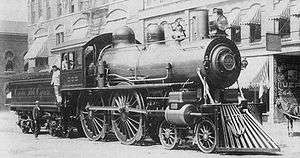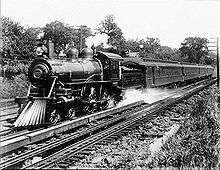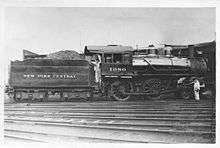New York Central and Hudson River Railroad No. 999
New York Central and Hudson River Railroad No. 999 is a 4-4-0 steam locomotive built for the New York Central and Hudson River Railroad in 1893, which was intended to haul the road's Empire State Express train service. It is claimed that in 1893 No. 999 was the first in the world to travel over 100 mph, although the probable maximum speed was 81 mph.
| NYC #999 | |||||||||||||||||||||
|---|---|---|---|---|---|---|---|---|---|---|---|---|---|---|---|---|---|---|---|---|---|
 Engine 999 in Syracuse. | |||||||||||||||||||||
| |||||||||||||||||||||
| |||||||||||||||||||||
| |||||||||||||||||||||
Development
In the early 1890s, the competition between the New York Central and Pennsylvania Railroads was growing fiercely. Their rivalry was particularly noticeable along their Chicago to New York corridors in the years leading to the Chicago World's Fair, with both roads trying to provide the most swift service to the fair. The Pennsylvania had upgraded its Pennsylvania Limited with the most modern and efficient rolling stock of the time. The New York Central similarly upgraded its Empire State Express train's rolling stock, however, knowing that this would not be enough, the road began exploring other options so as to outperform its rival.[1] To this end came George Henry Daniels, the road's chief public representative officer. He proposed a new locomotive design capable of exceeding the "magical" 100-mph speed barrier. This was a daring undertaking, as the engines at the time typically traveled at one-half of that speed, and there was very little experience in making such fast engines.
New York Central's Chief Superintendent of Motive Power & Rolling Stock, William Buchanan, had designed a class of 4-4-0 locomotives known as the Class "I", which were already capable of reaching high speeds, so it was simply a matter of making some modifications to an existing design. In 1893, locomotive #999 rolled out of the New York Central's West Albany Shops.
The 999 was mounted on 86-inch (220 cm) diameter driving wheels rather than the 70-inch (180 cm) driving wheels mounted on other engines of the class, and was the first of its kind to have brakes mounted to the front truck. The bands, pipes, and trim were highly polished; the boiler, smokestack, domes, cab, and tender were given a black satin finish, and "Empire State Express" was applied to the sides of the tender in 2 ft 6 in (762 mm) high gold leaf lettering.

World's fair and later service
No. 999 entered service in 1893, making the trip from Syracuse, New York. The Express was recorded travelling at 102.8 miles per hour (165.4 km/h) on May 9 and at 112.5 miles per hour (181.1 km/h) on May 10, between Batavia and Buffalo. If true it would have made No. 999 the first object on wheels to exceed 100 mph, but no documentation (i.e. passing times at a sequence of identified points) has been given. Furthermore the railway enthusiast and experienced timer of trains J.P. Pearson travelled behind 999 on May 10; he later described the trip in detail in his book Railways & Scenery. The highest speed he recorded between New York and Buffalo was 81 mph sustained for several miles while descending from Batavia to Buffalo, a high speed for a regular passenger train of that era, though one that had been exceeded by other locomotives in special trials.[2] Although 999 was fitted with a speed recorder the 100 mile an hour claims were only based on milepost timings by newspaper reporters. The highest speed seen on the speed recorder appears to be 86 miles an hour in April 1893.[3]
One contemporary magazine stated: "The information as to this seemed at that writing to be authentic, but since then a good deal of doubt, in which we share, has been thrown on the stated performance. We were misinformed as to the use of the speed indicator on the engine for one thing, and a careful consideration of all the conditions make the speed given improbable."[4]
Over 3,000 20 in (508 mm) gauge scale replicas (most of which were made by the Cagney Brothers and thus were referred to as "Cagneys") were sold at $1,500 each and shipped to amusement parks as far away as South Africa and Thailand; one such unit, nicknamed the "Little Puffer" is in service today at the Fleischaker Zoo in San Francisco, California. Manufacturers of electric train sets began putting No. 999 on their locomotives.

After the fair the engine continued to pull the Express between Buffalo and Syracuse. When the engine was sent to other parts of the road it was found to be slippery and hard to handle when pulling more than five cars. It was rebuilt with the same 70 inch drivers as the other engines of the class. In the 1920s it was given a new boiler and tender, operating local and branch line trains until 1924, when it was restored for exhibition at the Baltimore and Ohio Railroad's "Fair of the Iron Horse" the following year.
Retirement
Advances in locomotive design, particularly the advent of diesel-electric power, eventually rendered No. 999 obsolete. After touring the nation and making appearances at numerous expositions including the Chicago Railroad Fair, the unit was retired from service in May, 1952 at which time it was relegated to yard switching service in western New York shuttling express service milk cars. At this time, the railroad appeared to turn its back to steam power, and consequently, the majority of their steam engines, including all of their famed Hudsons, had been scrapped. However, when the matter of 999 came about, the road saw fit to preserve the famous engine. The New York Central donated the locomotive to the Chicago Museum of Science and Industry in 1962, though it did not arrive at the museum until 1968.
Once there, while its preservation was assured, the engine was displayed outside where exposure to elements had taken its toll over the years. In 1993, the museum underwent a major renovation. This project included a cosmetic restoration of number 999, and it was placed inside the museum's main hall. As displayed, the locomotive features its later 70" drivers as opposed to the original 86" drivers.[5]

See also
- City of Truro – another claimant for the first 100 mile an hour steam locomotive.
- Flying Scotsman – the first locomotive to reach an authenticated 100 miles an hour.
References
- Hollingsworth, Brian and Arthur F. Cook (1987). The Great Book of Trains. Portland House, New York, NY. ISBN 0-517-64515-7.
- "Empire State Express No. 999". Genesee County, New York. Archived from the original on December 30, 2005. Retrieved March 1, 2006.
- Fleet-wheeled wonder
- The Engineer of 7th March 1890 describes a North Eastern Railway J Class 4-2-2 reaching 90 mph.
- The Electrical Engineer 1893 Vol 15 p470
- American Machinist, 1st June 1893
- John Lienhard. "Rain, Steam & Speed: Inventing Powered Motion". Retrieved 2007-01-28.
External links
| Wikimedia Commons has media related to New York Central 999. |